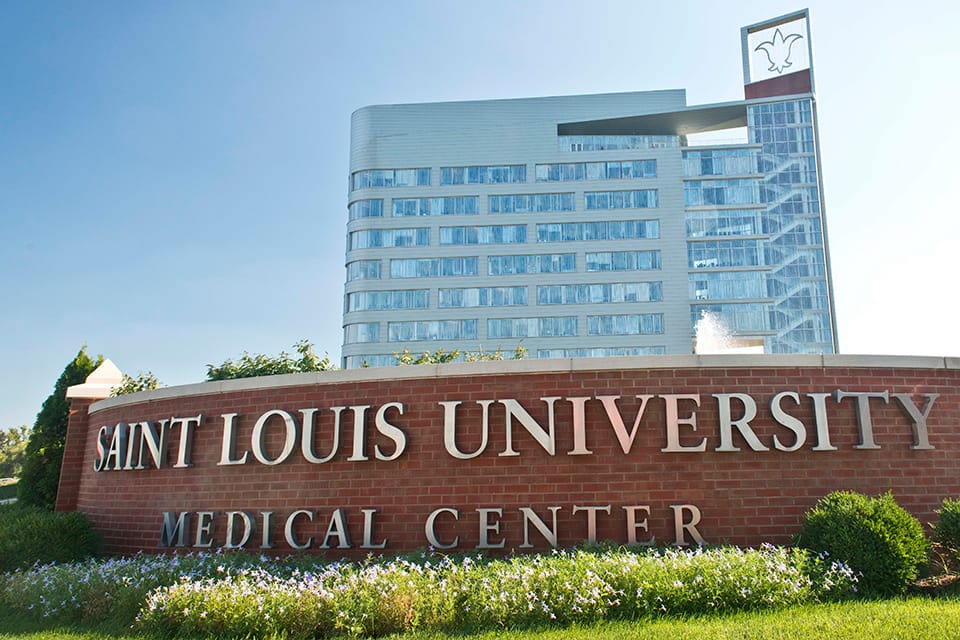SLU Named Center of Excellence for Hereditary Neuropathy
Saint Louis University is one of 10 medical centers in the nation to be named a Center of Excellence by the Hereditary Neuropathy Foundation (HNF). The designation recognizes strengths in clinical care and research for persons with hereditary neuropathy, also known as Charcot-Marie-Tooth (CMT) disease.
HNF will partner with SLU to become a hub for clinical care, community engagement, research and training and education for the Charcot-Marie-Tooth and inherited neuropathy community.
Charcot-Marie-Tooth affects 1 in 2,500 people or approximately 2.6 million people worldwide. The disease causes progressive nerve damage and those with CMT often develop difficulty walking and may become dependent upon assistive devices to remain mobile.
While CMT disease runs in families, the onset of symptoms and signs varies significantly between individuals. In young patients, parents or teachers may notice clumsiness with running, roller skating or jumping. But due to the slow progression of the illness, others only notice a problem as they reach their 50s.
CMT can impact a person's health in many ways. Clumsiness can lead to falls and falls can lead to injury. Loss of feeling and weakness can make it difficult to pick things up with one's fingers or negotiate uneven ground. CMT can worsen during pregnancy, and patients may worry about how CMT can affect their unborn children.
This new network will have the possibility to be mobilized and enrolled rapidly in new trials—which will ultimately save time and improve the chances of giving patients the therapies they currently do not have."
Allison Moore, Hereditary Neuropathy Foundation founder and CEO
As the illness advances, weakness and muscle atrophy also involves the hands, resulting in difficulty with fine motor skills. Pain can range from mild to severe, and many patients may need to rely on foot or leg braces to maintain mobility. Severe, chronic pain is common. Currently there is no cure and treatment focuses on optimizing hand and foot function with assistive devices and correcting foot deformities.
“Most subtypes associated with CMT genes are really rare, whereas a few account for the vast majority of CMT,” said Sean Goretzke, M.D., interim chair of neurology at SLU and a SLUCare pediatric neurologist. “At Saint Louis University, Dr. Florian Thomas led a team of international investigators that identified one such rare gene, YARS, which causes Dominant Intermediate CMT type C.
"And, he now leads a team that seeks to show if a combination of well established drugs can improve the outcome of the single most common type, CMT1A.”
Given the multiple challenges of living with CMT, a comprehensive approach that addresses the physical and emotional needs of patients and family members is important, Goretzke says.
“Our team, under the leadership of Dr. Thomas, includes nurses, genetic counselors, psychologists, physical and occupational therapists, other faculty neurologists and neurophysiologists, and provides excellent care for patients of all ages with CMT at both SSM Health Saint Louis University Hospital and at SSM Health Cardinal Glennon Children's Hospital," Goretzke said. "We are very pleased that the dedicated work of this team was recently recognized by the Hereditary Neuropathy Foundation, when it designated our facility as a Hereditary Neuropathy Foundation Center of Excellence.”
“Though the illness is not dangerous to a person’s life, it often leads to significant disability,” said Thomas, who is professor of neurology at Saint Louis University and a SLUCare neurologist. “We need to develop a treatment that can improve quality of life and neurological function for those with this difficult illness.”
Saint Louis University currently is enrolling patients in a phase III clinical trial to test a potential new medication to see if it is safe and effective at treating Charcot-Marie-Tooth Type 1A.
Hereditary Neuropathy Foundation founder and CEO Allison Moore expects that the new network of centers with expertise in treating and studying CMT will expand research opportunities.
"This new network will have the possibility to be mobilized and enrolled rapidly in new trials—which will ultimately save time and improve the chances of giving patients the therapies they currently do not have," Moore said.
The program launches with the following 10 institutions receiving Hereditary Neuropathy Foundation’s Center of Excellence designation:
- Brigham and Women's Hospital (Boston, MA)
- Cedars-Sinai Medical Center (Los Angeles, CA)
- Columbia University Neuropathy Research Center (New York, NY)
- Hospital for Special Care (New Britain, CT)
- Saint Louis University Medical Center (St. Louis, MO)
- Saint Luke's Rehabilitation Institute (Spokane, WA)
- University of Florida College of Medicine (Gainesville, FL)
- University of Kansas Medical Center (Kansas City, KS)
- University of Miami-Miller School of Medicine (Miami, FL)
- University of Minnesota Medical School (Minneapolis, MN)
"We are honored to have these premier Centers and their leading experts in partnership with us to improve the future for people with inherited neuropathies," Moore said.
With the Center of Excellence designation, the Hereditary Neuropathy Foundation aims to:
- Centralize care and clinical research into a collaborative research consortium with improved standard of best practice multi-disciplinary care in the management of Charcot-Marie-Tooth and providing services for families with Charcot-Marie-Tooth, such as therapeutic education;
- Select and support institutions that excel with regard to knowledge and experience in care for Charcot-Marie-Tooth and inherited neuropathies with a multi-disciplinary team;
- Establish effective partnerships between institutions and local communities to conduct innovative research and to improve care and eliminate health disparities;
- Strengthen existing training activities used to prepare clinicians and researchers to improve Charcot-Marie-Tooth care; and,
- Conduct community engagement and outreach efforts, including on-going workshops and forums to serve the local community with therapeutic education and support.
